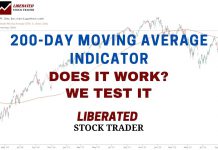The Buffett Indicator helps gauge stock market valuation. It compares total market capitalization to GDP, offering a macroeconomic perspective on market value.
To grasp the Buffett Indicator, we examine its components. Market capitalization reflects stock market valuation, revealing investor willingness to pay for ownership. GDP is a broad indicator of economic health. Comparing these measurements, the Buffett Indicator gauges if economic growth aligns with stock market valuations.

Analyzing the Buffett Indicator involves looking at historical trends and data to determine an average or extreme market valuation. While no single metric is a crystal ball, the Buffett Indicator has been a starting point for many when assessing market conditions. It’s important to consider the limitations and critiques of this indicator, such as changes in economic structure, globalization, and the evolving nature of financial markets.
Key Takeaways
- The Buffett Indicator compares stock market capitalization to GDP to assess market valuation.
- It provides a broad macroeconomic perspective on whether the market is overvalued or undervalued.
- Historical trends are crucial for interpreting the indicator’s signals about market conditions.
- Limitations such as changes in economic structure and globalization must be considered when assessing the indicator.
Origins of the Buffett Indicator
The Buffett Indicator has become a widely recognized market analysis tool closely associated with the investment approach of Warren Buffett. It offers a macro-level view of market valuations by comparing total market capitalization to gross domestic product.
Warren Buffett’s Philosophy
Warren Buffett, the chairman and CEO of Berkshire Hathaway, is renowned for his value investing philosophy, which emphasizes fundamental analysis. He advocates for investments in companies with strong underlying businesses and views the stock market as a means to purchase these businesses at a fair price. Fundamental elements of the economy, such as gross domestic product (GDP), are integral to his analysis.
The Birth of a Market Metric
The Buffett Indicator is not Buffett’s creation, but it was named after him due to his investment strategies and discussions on market valuation. Journalist Carol Loomis played a vital role in popularizing this metric through her writings. In a 2001 article, Loomis mentioned this indicator after a conversation with Buffett, stating that the ratio of total market cap to GDP is a reliable measure of valuations. This metric quickly gained popularity as an indicator of stock market valuation relative to the economy.
Understanding the Indicator
The Buffett Indicator measures the total market capitalization of publicly traded stocks to a country’s Gross Domestic Product (GDP), offering insight into whether a stock market is overvalued or undervalued.
GDP Ratio Fundamentals
GDP, the total monetary or market value of all the finished goods and services produced within a country’s borders in a specific period, is a broad measure of a country’s economic activity. Concerning the Buffett Indicator, analysts typically use annual US GDP data as a benchmark.
- US GDP: Provides a snapshot of the economic health and potential productivity of the United States.
Market Capitalization Explained
Market capitalization refers to the total dollar market value of a company’s outstanding shares of stock. To calculate market capitalization, one multiplies the current market price of a single share by the total number of outstanding shares.
- Total Market Cap: Equivalent to the total value of all publicly traded company shares in the United States.
Comparing GDP and GNP
While GDP focuses on location, Gross National Product (GNP) gauges the value of goods and services produced by a country’s citizens, regardless of their location. Comparing GDP and GNP can provide nuanced insights, yet the Buffett Indicator primarily relies on GDP to assess stock market valuation.
- GNP: Represents the total value of all goods and services produced over a set period by nationals of a country and can highlight the economic impact of national corporations operating abroad.
- Market analysts frequently juxtapose the US GDP with the total market cap to use the Buffett Indicator as a temperature check for the stock market.
Calculating the Buffett Indicator
The Buffett Indicator is obtained by comparing the total market capitalization of publicly traded stocks to the gross domestic product (GDP). This ratio offers insights into market valuation and potential over- or undervaluation.
Wilshire 5000 Usage
The Wilshire 5000 Total Market Index is often the preferred metric for representing the total market capitalization of publicly traded US stocks. It is comprehensive, encompassing most equity securities traded in the United States. To calculate the numerator of the Buffett Indicator:
- Obtain the most recent Wilshire 5000 index value.
- Multiply this value by the latest reported total shares outstanding to derive the cumulative market capitalization.
It is vital to use up-to-date data to reflect current market conditions accurately.
See this chart live on TradingView
GDP Data Sources
For the denominator of the Buffett Indicator, reliable GDP data is required. The primary source for this information in the United States is the Bureau of Economic Analysis (BEA). The BEA’s GDP data can be accessed via:
- BEA’s official website: For comprehensive GDP reports.
- Federal Reserve Economic Data (FRED): The Federal Reserve Bank of St. Louis maintains a database that offers interactive charts and a user-friendly interface for GDP figures.
See this chart live on TradingView
To maintain accuracy, it is essential to use the most current GDP data, with quarterly updates helping to ensure the Buffett Indicator reflects the latest economic conditions.
Analyzing Market Valuation
When assessing the health of stock markets, the Buffett Indicator serves as a key metric for understanding overall market valuation. Investors gauge whether the market is overvalued or undervalued, which can inform investment decisions.
Interpreting Overvaluation and Undervaluation
To interpret market valuation, one examines the total market capitalization relative to the gross domestic product (GDP), as the Buffett Indicator suggests. A market is considered overvalued when its valuation is significantly higher than the historical average. In this case, the Buffett Indicator would show a percentage over 100%, indicating that the stock market is priced higher than the economic output. This suggests investors are paying more for each dollar of company earnings, which could be due to high investor optimism or market speculation.
Conversely, a market is perceived as undervalued when the Buffett Indicator is below the historical average or 100%, indicating that the market valuation is low relative to the GDP. This can imply that stocks are potentially a bargain, reflecting a pessimistic outlook from investors or a lack of confidence in the economy.
Comparative Valuation Techniques
Investors use valuation multiples to compare the current market price of a company to its earnings or other financial metrics. Two commonly analyzed multiples include:
- P/E Ratio: The price-to-earnings (P/E) ratio compares a company’s share price to its earnings per share. A high P/E might indicate a company is overvalued relative to its earnings, while a low P/E may suggest undervaluation.
P/E Ratio Market Implication High P/E Potential Overvalue Low P/E Potential Undervalue - Shiller P/E Ratio: The cyclically adjusted price-to-earnings ratio (CAPE) adjusts for inflation and cyclicality by averaging earnings over 10 years. The Shiller P/E is a more stable metric and can provide a clearer long-term view of market valuation compared to standard P/E.
See this Shiller chart live on TradingView
Investors rely on these tools to analyze individual securities or the market as a whole, determining where the current valuation stands in historical context.
Historical Performance
The Buffett Indicator has shown its value as a metric by reflecting the trends and potential for mean reversion in market valuation over time. It also offers insights when examined in the context of extraordinary events—such as financial crises—by comparing stock market capitalization in relation to the gross domestic product (GDP).
Historic Trends and Mean Reversion
Historically, the Buffett Indicator has oscillated around a mean, suggesting that market valuation tends to revert to a long-term average. The mean serves as a benchmark, indicating whether the stock market is overvalued or undervalued relative to GDP. For instance, the indicator has a historical mean of approximately 100% over several decades, with standard deviations marking periods of market exuberance or pessimism.
- Historical mean: Approximately 100%
- Standard deviation: Varies over time
Market cycles have demonstrated peaks and troughs around this mean, signaling investors when market valuation may be stretched or, conversely, when it may present a value opportunity.
Financial Crisis Case Study
During the financial crisis of 2007-2008, the Buffett Indicator sharply deviated below its historical mean. This signaled an undervaluation of the stock market relative to the size of the economy.
- Pre-crisis peak: Significantly above 100%
- Post-crisis trough: Markedly below 100%
The drop below the mean implied that stock market capitalization was significantly devalued after the crisis, a pattern observed in historical data for such economic downturns. As the economy recovered, the indicator, too, returned toward its mean, aligning with the concept of mean reversion that characterizes this measurement’s long-term behavior.
Using the Buffett Indicator
The Buffett Indicator is a measure of market valuation that compares the total market capitalization of publicly traded stocks to the gross domestic product (GDP) of a country. It serves as a barometer for whether the stock market is overvalued or undervalued.
Here’s how to interpret the Buffett Indicator:
- High Indicator: When the total market capitalization is high relative to GDP, the Buffett Indicator will produce a high percentage. This is often interpreted as the stock market is overvalued, suggesting that stocks may be expensive compared to the earnings of the overall economy. A common threshold for considering the market as significantly overvalued is when the indicator is well above its historical average, such as 100% or higher in the United States. However, this threshold can vary by country.
- Low Indicator: Conversely, a low percentage indicates that the total market capitalization is low relative to GDP, which could mean the stock market is undervalued. This might suggest that stocks are cheap compared to the size of the economy. A figure significantly below the historical average, such as 50% or 70%, might be a potential undervaluation indicator.
Get the Buffett Indicator on TradingView
It’s important to note that while the Buffett Indicator can provide a macro-level snapshot of market valuation, it is not without its limitations:
- Globalization: The revenues and profits of large corporations often come from global operations, not just domestic ones. This can distort the ratio if a country’s businesses have a large international footprint.
- Interest Rates: The indicator does not account for current interest rates. Lower interest rates can justify higher valuations, as investors are willing to accept lower yields in exchange for the potential growth provided by stocks.
- Market Dynamics: The indicator does not consider other market dynamics or investor sentiment, which can significantly impact stock prices.
- Sector Composition: Different economies have different sector compositions, which can affect the ratio. For example, an economy with a large technology sector might have higher valuations due to faster growth prospects.
- Economic Cycles: The indicator may not be as effective during extreme economic cycles, such as recessions or booms, when GDP might not accurately reflect the economy’s long-term productive capacity.
As an Investment Tool
As an investment tool, the Buffett Indicator provides a high-level perspective on the stock market’s valuation relative to an economy’s output. When using it, investors often look for the following:
- Market Cap to GDP Ratio: A ratio greater than 100% may suggest that equities are overpriced, while a ratio below 100% might imply that stocks are undervalued.
- Historical Comparisons: By comparing current ratio levels to historical averages, investors gauge market conditions against past market cycles.
Investors should consider the following when using the ratio:
- Data Sources: Reliable and current sources of total market capitalization and GDP figures are vital for accuracy.
- Local Market Conditions: The indicator may vary significantly between different economies, which should be considered in global investing.
Warnings and Indications
The Buffett Indicator is also a warning signal for potential market corrections when equity prices are significantly higher than GDP growth. It can indicate:
- Overvaluation: A much higher-than-average ratio may warn of an overheated market, possibly leading to a future downturn.
- Undervaluation: Conversely, a lower ratio could suggest a market is undervalued, presenting potential buying opportunities.
Investors should heed these cautions:
- False Signals: The indicator might give false signals, as it does not account for interest rates or other economic factors affecting stock valuations.
- Economic Shifts: Structural changes in the economy, such as a move towards a more digitized economy, can affect the relevance of historical ratio comparisons.
Limitations and Critiques
Despite its widespread use, the Buffett Indicator, like any tool, has inherent limitations and has attracted a variety of critiques from the financial community. These concern both the accuracy and reliability of the metric as well as external factors that can significantly affect its readings.
Accuracy and Reliability
The Buffett Indicator’s accuracy is debated, particularly with respect to its consideration of corporate profits. Critics argue that the indicator may not always reflect an accurate picture of economic conditions, as it relies on aggregate data that can be skewed by outliers or sectors not representative of the broader economy. Moreover, the metric might not fully account for inflation’s impact on corporate earnings and market valuations.
External Factors Impacting the Indicator
Several external factors can influence the reliability of the Buffett Indicator. These include:
- Monetary Policy: Decisions by the Federal Reserve Bank, especially concerning interest rates, can greatly affect stock market valuations independently of corporate earnings. A low interest rate environment tends to increase the attractiveness of stocks, potentially skewing the indicator’s readings.
- Inflation: Inflation can distort the picture provided by the indicator by affecting both the numerator (market capitalization) and the denominator (GDP), often in different directions. This makes the indicator less reliable during periods of high inflation.
- Corporate Debt: High levels of corporate debt can alter the perception of a company’s value, as the debt may lead to increased risk, which the Buffett Indicator does not directly take into account.
These criticisms underline the importance of using the Buffett Indicator as one of several tools in assessing market valuations rather than relying on it in isolation.
The Indicator and the Federal Reserve
The Buffett Indicator often intersects with the policies of the Federal Reserve, particularly as they relate to interest rates and broader economic guidance.
Interest Rate Influence
The Federal Reserve Bank of St. Louis plays a significant role in economic research, which can inform interest rate decisions that influence the Buffett Indicator. Interest rates, set by the Federal Reserve, directly affect the stock market valuations that are central to the Buffett Indicator’s calculation. When interest rates are low, they can lead to higher market valuations, whereas high rates can have the opposite effect, making bonds more attractive compared to stocks.
Federal Reserve’s Economic Policies
The Federal Reserve Bank’s economic policies, including the adjustment of interest rates, aim to manage inflation and control economic growth. The Federal Reserve’s actions can cause movements in the Buffett Indicator by altering investors’ expectations and influencing market sentiment. Investors may anticipate slower economic growth and potential market corrections when the Federal Reserve raises interest rates. Conversely, when the Federal Reserve lowers rates, it can boost investor confidence and drive up the stock market, affecting the indicator’s status.
Global Perspective
The Buffett Indicator, commonly used to gauge stock market valuation, extends beyond the United States, offering insights into global markets relative to economic output.
Buffett Indicator Beyond the United States
The concept of the Buffett Indicator stems from comparing the total market capitalization to the Gross Domestic Product (GDP), a measure historically associated with the US market. However, when applied globally, one finds varied interpretations and uses of this metric.
- United States: The US stock market is typically used as a benchmark, with a higher Buffett Indicator signaling potential overvaluation. For example, a ratio exceeding 100% might suggest that the stock market is valued higher than the country’s economic output, prompting investors to exercise caution.
- Global Market: To assess the global market’s valuation, analysts aggregate the world’s total stock market capitalization and compare it to the world GDP. This provides a composite picture of international investment climates.
- GDP Ratio: Each country’s market can be evaluated individually against its GDP. Developing markets might have lower ratios, indicating potential growth, whereas advanced economies may show higher ratios, suggesting maturity or overvaluation.
The indicator’s interpretation requires context; it fluctuates with economic cycles, interest rates, and market sentiment. It is important to consider that the Buffett Indicator is not a standalone tool and should be used alongside other financial analysis methods to understand the global market’s position.
Practical Application
The Buffett Indicator is a key metric for evaluating market valuation and can significantly influence investment strategies and decisions. It gives insight by comparing the total market capitalization to gross domestic product (GDP), serving as a gauge for whether the stock market is undervalued or overvalued.
Incorporating into Personal Investing Strategy
Individual investors may use the Buffett Indicator as part of their due diligence when entering the stock market, especially to guide timing and allocation decisions. For instance:
- Before an IPO: One might assess the Buffett Indicator to decide the opportune moment to invest in an Initial Public Offering (IPO). If the indicator suggests an overvalued market, they may proceed cautiously or delay entry.
- Asset Allocation: They may adjust their portfolio’s equity exposure based on the indicator’s current value. A high ratio may lead to increased investments in bonds or savings, whereas a low ratio might justify a heavier stock allocation.
Future of Market Assessment
The approach to market assessment is evolving rapidly, with technology playing a crucial role. Precise predictions for the Buffett Indicator involve complex variables that resist simple forecasting methods.
Technological Advancements in Data Analysis
Several financial institutions and analysts, including those from Wall Street, are leveraging new technological tools to enhance the assessment of market metrics. With the advent of sophisticated algorithms and machine learning, data analysis for metrics like the Total Market Index is becoming increasingly refined. As a result, the accuracy and speed of market predictions are anticipated to improve.
Investment professionals often rely on specialized websites to track live data and content updates related to market indicators. In the future, it is expected that such websites will become more interactive and user-friendly, employing advanced data visualization tools to represent complex data sets succinctly.
Predictions for the Buffett Indicator
The Buffett Indicator, which compares the total market capitalization to the GDP, serves as a significant market metric for investors. Looking forward, experts predict that this indicator will adapt to account for the global nature of modern markets, perhaps evolving beyond its current form.
| Potential Changes | Impact on Market Assessment |
|---|---|
| Global Market Inclusion | More comprehensive assessment of market valuation. |
| Real-Time Data Integration | Enhanced reactivity to market changes. |
| Adjustment for Inflation & Currency | Improved accuracy in long-term market predictions. |
Predictive models are becoming more sophisticated, integrating various indices and external economic factors to provide a more nuanced understanding of future market trends. This complexity might yield new variants of the Buffett Indicator, mirroring the changes in how markets function today.
Frequently Asked Questions
What is the Buffett indicator?
The Buffett Indicator is a popular financial metric that compares a country's stock market capitalization to its Gross Domestic Product (GDP), offering insight into whether a market is overvalued or undervalued.
What is the relationship between market cap and GDP in the Buffett Indicator?
The Buffett Indicator takes the total market capitalization of all publicly traded stocks and divides it by the Gross Domestic Product. It reflects the overall stock market valuation relative to the economic output of a country.
How is the Buffett Indicator calculated?
To calculate the Buffett Indicator, one divides the total market capitalization of the country's stock market by the latest quarterly figures for GDP. The result is then expressed as a percentage.
What does the historical chart of the Buffett Indicator suggest about market valuation trends?
The historical chart of the Buffett Indicator shows periods of overvaluation or undervaluation in the market. A significantly high ratio suggests the market is overvalued, while a low ratio would suggest the opposite.
Does Warren Buffett rely on this indicator for investment decisions?
Warren Buffett has referred to this indicator as a gauge for the market's valuation. However, it is not publicly known if he relies solely on this indicator for his investment decisions.
How does the Buffett Indicator vary by country?
The Buffett Indicator can vary widely by country, reflecting different levels of stock market development, investor sentiment, and economic conditions. Developing markets may show a lower ratio compared to developed markets.
Can the Buffett Indicator be used to determine if the stock market is overvalued?
The Buffett Indicator can suggest whether a stock market is overvalued or not when analyzed in a historical context. A number above the long-term average may signal overvaluation, whereas a number below might indicate undervaluation. However, relying solely on this indicator without considering macroeconomic factors and market nuances can be misleading.





